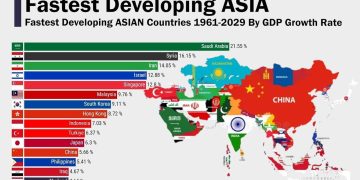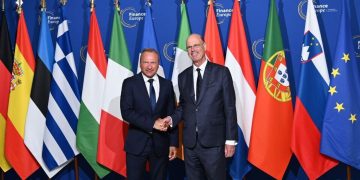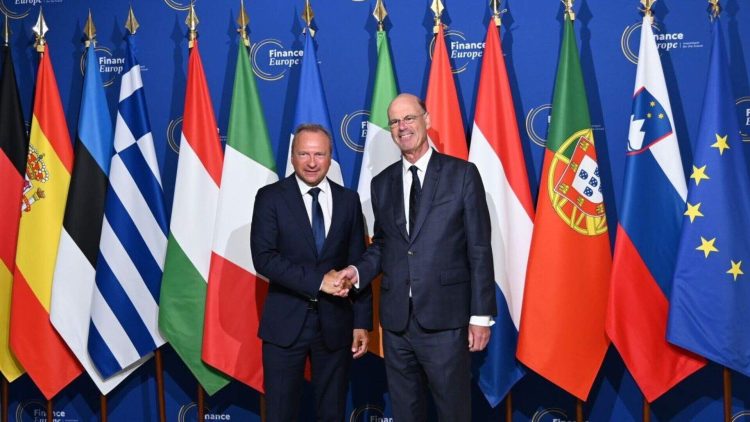Introduction
Europe’s economy in late 2025 faces a defining paradox: inflation has begun to retreat from its multi-year highs, yet the path toward monetary normalization remains uncertain. The European Central Bank (ECB), under immense pressure from both governments and markets, walks a delicate tightrope—balancing the need to curb inflation without crushing already fragile growth.
This tension has come to define the European economic narrative. Unlike the U.S., where growth remains surprisingly resilient, Europe’s slowdown is structural, its inflation partially supply-driven, and its monetary tools less flexible. As the ECB recalibrates its policies, the stakes could not be higher—for the euro’s credibility, for business confidence, and for the stability of the entire Eurozone.
1. The Long Shadow of Inflation
The inflation story in Europe is complex. What began as a post-pandemic supply shock—exacerbated by the Russia-Ukraine war and the ensuing energy crisis—has evolved into a more persistent phenomenon. Food and energy prices initially led the surge, but core inflation (excluding those volatile components) has proven sticky, driven by labor market rigidity and rising wage demands.
By mid-2025, Eurozone inflation had fallen from its 2023 peak of over 10% to around 3%, but this apparent success hides deeper fragilities. Inflation expectations remain volatile, and regional disparities persist: countries like Spain and Portugal have stabilized faster than Germany and the Netherlands, where industrial energy costs continue to bite.
2. The ECB’s Balancing Act
The European Central Bank’s mandate—maintaining price stability—has rarely been tested as severely as in the past two years. After an aggressive tightening cycle between 2022 and 2024, which pushed interest rates to multi-decade highs, the ECB now faces political and social fatigue.
The key dilemma: when to cut rates.
- Cut too early, and inflation may reaccelerate.
- Wait too long, and the Eurozone could slide into a deep recession.
ECB President Christine Lagarde has emphasized a “data-dependent approach,” signaling caution. Yet markets are impatient, pricing in modest cuts by late 2025. The divergence between the ECB and the U.S. Federal Reserve—whose policy easing began earlier—has also pressured the euro, adding another layer of complexity.
The ECB’s cautious stance reflects more than economic prudence; it reveals the institutional memory of past crises. From the 2010 sovereign debt crisis to the 2015 deflationary spiral, Europe has learned the cost of misjudged timing. The central bank now prioritizes credibility, even at the expense of short-term growth.

3. The Real Economy Feels the Strain
High borrowing costs have rippled across the continent.
- Businesses face tighter credit conditions, especially small and medium-sized enterprises (SMEs) that form the backbone of southern Europe’s economy.
- Consumers delay spending on housing and durable goods as mortgage rates soar.
- Governments, many already burdened by pandemic-era debt, find it increasingly difficult to finance new fiscal programs without raising taxes or cutting social spending.
This credit contraction has translated into weak investment and declining productivity—further constraining long-term potential. While inflation moderation offers some relief to households, the broader sentiment remains cautious. Economic growth in the Eurozone is projected at a meager 0.8% for 2025—barely escaping stagnation.
4. The North-South Divide Returns
The current monetary tightening has also revived old divisions within the Eurozone.
Northern economies, particularly Germany and the Netherlands, push for strict inflation control, fearing erosion of purchasing power and savings.
Southern economies—Italy, Greece, and Spain—argue for flexibility, emphasizing employment and fiscal space.
This divergence in national priorities complicates ECB policymaking. A “one-size-fits-all” interest rate inevitably benefits some while hurting others. In practice, this asymmetry means that while inflation in Italy may have normalized, Germany’s export slump makes rate hikes feel disproportionate.
The ECB has sought to address this imbalance through targeted instruments like the Transmission Protection Instrument (TPI)—designed to prevent bond market fragmentation. Yet critics argue these tools treat symptoms, not causes, of structural divergence.
5. The Geopolitical Undercurrents
Monetary policy does not exist in a vacuum. The ECB’s strategy unfolds amid a turbulent geopolitical landscape:
- The Russia-Ukraine conflict continues to disrupt energy and agricultural trade routes.
- China’s economic slowdown affects European export demand.
- The U.S. Inflation Reduction Act lures green investment away from Europe.
These forces complicate inflation forecasting, as supply-side shocks remain unpredictable. The ECB can tame domestic demand but cannot control the price of global commodities or the security of energy pipelines.
Meanwhile, Europe’s fiscal policy remains fragmented. While the EU has agreed on a new set of fiscal rules to replace the Stability and Growth Pact, national-level disagreements persist. Without a unified fiscal response, monetary policy bears too much of the burden.
6. Signals from the Markets
Financial markets interpret every ECB statement as a signal of future direction. Bond yields remain elevated, reflecting both inflation uncertainty and skepticism about Europe’s growth prospects. Equity markets, however, have shown resilience—especially in green technology, luxury goods, and defense sectors.
The euro’s performance tells another story. Despite inflation cooling, the currency has weakened against the dollar and Asian currencies, revealing investors’ doubts about Europe’s medium-term momentum. For the ECB, this creates another paradox: a weaker euro supports exports but also raises import prices, complicating inflation management.
7. What Comes Next?
By late 2025, the ECB will likely begin a cautious rate-cutting cycle—tentatively and gradually.
But this is not a return to the ultra-loose monetary policy of the 2010s. The ECB’s internal consensus now views zero or negative rates as risky distortions rather than safe defaults.
Future monetary policy will likely be defined by three priorities:
- Price Stability Above All – Inflation control will remain the ECB’s north star, even if growth sacrifices persist.
- Targeted Liquidity Support – Credit facilities may be designed to help SMEs and green industries rather than broad stimulus.
- Fiscal-Monetary Coordination – The next decade may see stronger EU-level fiscal frameworks to complement monetary efforts.
8. Conclusion: Walking the Tightrope
The European Central Bank’s challenge is more than technical—it is existential. The credibility of the euro itself depends on the ECB’s ability to steer between inflation and stagnation without losing public trust.
Europe’s economic identity has long rested on stability, predictability, and consensus. But in an era defined by shocks—pandemic, war, climate transition—such stability requires adaptation, not nostalgia.
The ECB’s tightrope walk will define Europe’s financial architecture for the next decade. Whether it succeeds depends not only on monetary precision but on political will—on whether Europe’s leaders can match economic realism with collective vision.
































